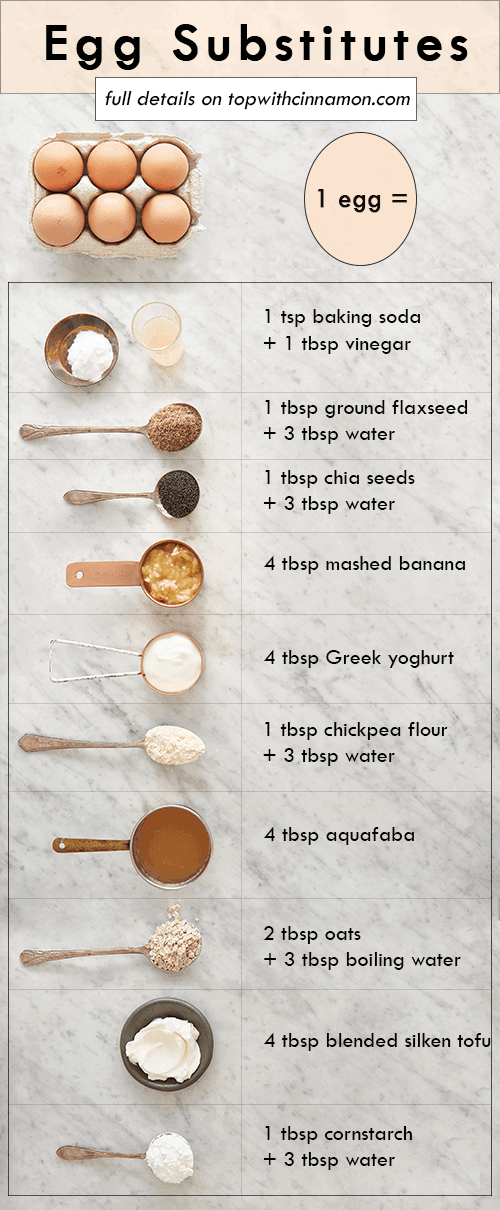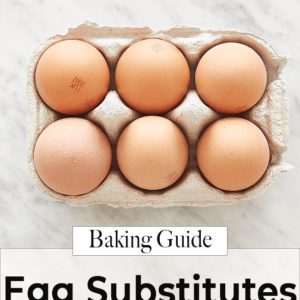
This post has been updated as of August 2021
A lot of the time when developing vegan baking recipes, I prefer to start with a standard recipe and make plant-based substitutions. One of the main things I find myself experimenting with are different vegan egg substitutes. Have you ever wondered what ingredients could be used as an egg substitute in baking? and which of those substitutes work best in different situations? Below you’ll find quite a comprehensive list of common ingredients you can use instead of eggs, how much to use to replace 1 egg & which applications each one is best for.
Eggs have many properties which we use in cooking & baking (binding, aeration/rise, spongey texture, creaminess, thickening, browning, stabilisation) so each substitution provided usually covers some but not all of those properties – hence needing different substitutes for different recipes.
Even if you’re not vegan or allergic to eggs I think it’s useful to know a few of these substitutes for if you’re ever in a situation where you don’t have/can’t get eggs. You can pin the graphic above (or even save it) for future reference!
- Baking soda + vinegar
- Ground flaxseed
- Chia seeds
- Mashed banana, applesauce, pumpkin puree
- Greek yoghurt
- Chickpea flour
- Aquafaba
- Oats
- Silken tofu
- Cornstarch
- Bonus: Psyllium Husk
- Bonus: Egg wash substitutes
Baking Soda + Vinegar
An interesting combination which provides the lift and browning to vegan cakes missing from not including eggs. This is very limited in application but works extremely well for certain recipes.
1 egg = 1 tsp baking soda + 1 tbsp vinegar
- Method: Unless you are confident in making changes to recipes I would only use this substitute in recipes which have been specifically developed using it. These types of recipe are easy enough to find by googling!
- Best for: chocolate cakes, other fluffy layer cakes and cupcakes, pancakes
- Benefits: most people will have these already to hand, cheap
- Example recipe: Caramelised Banana Buckwheat Bread
Ground Flaxseed (Linseed)
Flaxseeds can come whole or pre-ground. If they’re pre-ground and you live in a warm climate, store in the fridge or freezer to prevent it going rancid. If you have whole flaxseed, use a spice grinder or blender to blitz them into a fine powder before using as an egg substitute.
1 egg = 1 tbsp ground flaxseed + 3 tbsp (45g) warm water
- Method: Mix the flaxseed and water together in a small bowl and set aside until the mixture becomes slightly thick and gelatinous (around 5 minutes). You can now use it in your recipe as you would an egg.
- Works best for: Muffins, cakes, quickbreads, cookies, cornbread
- Benefits: high in fibre, high in omega 3 fatty acids, neutral taste, easy to find
- Example recipe: Vegan Lemon Poppyseed Muffins
Chia Seeds
Chia seeds come either as black or white small seeds. You can choose the white ones if you don’t want to see black speckles in the final product. They are used whole so remain kind of crunchy in the final bake and can get stuck in your teeth. Once mixed with water the chia seeds form a fibrous, mucilaginous (slimy!) clear liquid.
1 egg = 1 tbsp whole chia seeds + 3 tbsp water
- Method: Mix the chia seeds and water together in a small bowl and set aside until the seeds have formed a gelatinous goop around them and thickened up a lot
- Works best for: muffins, quickbreads, cookies (& sometimes brownies)
- Benefits: high in fibre, high in unsaturated fats, high in protein, no need to grind before using
Mashed banana, applesauce, pumpkin puree
These all work in a similar way with a smooth, slightly thick but watery texture. They can impart a flavour (mashed banana) or a colour (pumpkin puree) but the most neutral is plain, unsweetened applesauce. They can make things have a slightly denser texture so are best used for heartier bakes.
1 egg = 1/4 cup (60ml) mashed banana or applesauce or pumpkin puree
- Method: mash/blend banana until very smooth (use smooth, unsweetened applesauce/pumpkin puree) and mix into recipe as you would an egg.
- Works best for: heartier bakes such as pancakes/waffles, muffins, quickbreads
- Benefits: easy to access and use
- Example recipe: Vegan Sourdough Banana Bread
Greek Yoghurt
Very similar to how you would use mashed banana/applesauce/pumpkin puree (but not vegan!). Yoghurt can help provide a tender texture so is best for cakier products. As it’s high in protein and contains some sugars, it can also give your bakes a lovely golden-brown appearance. You can also use a thick, unflavoured soy yoghurt here if needed to make something dairy free/vegan.
1 egg = 1/4 cup (60ml) Greek yoghurt (or thick soy yoghurt)
- Method: use as you would an egg in your recipe.
- Works best for: quickbreads, muffins, pancakes
- Benefits: easy to access, provides some tenderness, high in protein, helps with browning
- Example recipe: Lemon Yoghurt Pot Cake
Chickpea Flour (Gram flour)
A pale yellow, fine flour, commonly used in Indian recipes. This flour has a distinctly ‘beany’ scent and can make the batter of your bakes taste a bit earthy. Don’t worry though, once baked the flavour is lost. This can even be used to make vegan ‘scrambled eggs’ or ‘omelettes’ – you just need to incorporate some salt and spices/herbs into your chickpea flour ‘batter’ and fry with some oil in a frying pan.
1 egg = 1 tbsp chickpea flour + 3 tbsp (45ml) water
- Method: Place the flour in a small bowl and mix together with the water until you get a smooth paste.
- Works best for: cakier products like cakes, quickbreads, muffins, deep frying (egg substitute for when you’re breadcrumb-coating things), French toast batter, crepes/pancakes, scrambled ‘eggs’/ ‘omelettes’ or quiche (in combo with silken tofu), meatballs / meatloaf
- Benefits: high in protein, high in fibre, imparts a golden colour to bakes, has a neutral flavour once cooked
- Example Recipe: Butternut Squash & Caramelised Shallot Tart
Aquafaba (Chickpea Water)
The brine which is usually drained away and discarded from a can of chickpeas (or even black beans, kidney beans, cannellini beans) can be used as an egg white substitute. It whips up just like egg whites do, although tends to take longer to reach stiff peaks, and can be used for similar applications. Unlike egg whites, the foam produced by aquafaba will not solidify once cooked so it needs sugar (or something else like melted chocolate e.g. if using for a mousse) to be whisked into it in order to stabilise it.
The viscosity of aquafaba can vary from brand to brand (as well as if you’re using water from beans you’ve cooked yourself) – if you tried whipping it and it doesn’t seem to work, reduce the liquid down by 50% by gently simmering it in a small pot on the stove.
1 egg = 1/4 cup (60ml) aquafaba
- Method: either use straight from the can or reduce (as described above) if needed before using. Can mix straight into batters/doughs or whip it up in a stand mixer (with or without sugar, as you would meringue) until you get thick, white fluffy foam just like whipped egg whites.
- Best for: things where egg whites are used like meringues, mousse, Swiss meringue buttercream. Also can be used for cookies, waffles/pancakes, deep frying (egg sub. for breadcrumb coating things), and cakes.
- Benefits: uses something you’d usually throw away, can be frozen for use in the future, light fluffy texture.
- Example recipe: Vegan Molten chocolate cakes
Oats
When oats are combined with boiling water they thicken and become a bit gloopy (i.e. porridge!). This can then be used as is (or blended to form a sticky, smooth paste) and used as an egg substitute.
1 egg = 2 tbsp oats + 3 tbsp boiling water (fine/instant/porridge oats work best here – not old fashioned oats)
- Method: Place the oats in a small bowl, cover with the boiling water and set aside until thickened and cooled. This mixture can then be blended into a smooth paste if having a slightly oaty texture in the finished bake isn’t desired.
- Best for: cookies, muffins, quickbreads, pancakes/waffles
- Benefits: common pantry ingredient, cheap, high in fibre
- Example recipe: Vegan Chocolate Chip Cookies
Silken Tofu
This tofu is usually shelf stable so is normally found on supermarket shelves (i.e. not in the chilled section). It has a wobbly and very soft texture. Once blended into a smooth paste it can be used in place of eggs in baking. Or it can also be mashed with the back of a fork and used as a ‘scrambled egg’ sub, if fried with some spices and dried herbs. You can blend up a whole block and store in pre-measured 1/4 cup (60ml) portions in the freezer so you don’t end up wasting any.
1 egg = 1/4 cup (60ml) blended silken tofu
- Method: blend with a hand blender, food processor or blender until smooth. Measure and then mix into your recipe as you would an egg.
- Best for: cakes, muffins, quickbreads, quiche (in combo with chickpea flour), scrambled egg
- Benefits: provides a light texture so good for cakes, high in protein, shelf stable
- Example recipe: Marble Cake (vegan option)
Cornstarch (cornflour)
As cornstarch thickens into a clear-ish gel when heated, and can set into a firmer, jelly-ish texture when cooled, it does a great job at thickening liquids instead of eggs. This is mostly useful for custards and pie fillings so is great for making eggless custards, creme patissiere, pudding and vegan ice cream. Other starches will work in a similar fashion too (tapioca, arrowroot, potato starch).
1 egg = 1 tbsp cornstarch + 3 tbsp (45ml) water
- Method: mix in a small bowl to form a slurry. If using in something that gets baked (like a cake), just stir straight into the batter/dough. If using for custards/pie fillings, mix with the remaining liquid in the recipe and then cook on the stove over a low heat, stirring until thickened.
- Best for: custards (ice cream, creme patissiere, pudding), pie fillings (e.g. pecan pie), lemon curd
- Benefits: easy to use, accessible & cheap
- Example recipe: Pistachio Ice Cream
Bonus: Psyllium Husk
This one I learnt about from School Night Vegan. Psyllium husk acts in a very similar way to flax or chia seed, creating a mucilaginous mixture when combined with water. However, psyllium husk actually produces a much stronger gel (so strong in fact, that it is often used in gluten-free bread recipes to replace the gluten!). It can be a bit harder to find, usually it’s sold as a healthcare product/supplement as, being very high in fibre, it is beneficial for your digestive health. Otherwise you can find it online. It comes in two forms: whole and powdered – make sure you know which type you have as the powdered form is more concentrated.
1 egg = 1 tsp whole psyllium husks or 1/2 tsp ground psyllium husk + 3 tbsp water
- Method: if using whole psyllium husks, grind them in a spice grinder before starting. Mix the ground psyllium husk with the water in a small bowl and leave for a few minutes to gel. Combine the gel with any liquid from your recipe (e.g. milk, juice, water) and blitz until smooth with a hand blender or standing blender.
- Best for: cakes, breads, cookies, muffins, pastry
- Benefits: cheap, works well in a variety of recipes, stronger gel than flax/chia
- Example recipe: vegan chocolate chip sheet cake
Bonus: Egg wash substitutes
Vegan substitutes for egg washes (for glazing things like pastries and breads before baking) are one of the trickier things to get right. Usually, egg wash provides 3 things: stickiness (to adhere seeds or seal pastry), sheen and a golden-brown hue. There are a few different types of vegan egg washes that I like to use depending on the situation & what I have to hand.
- 1 tbsp maple syrup + 1 tbsp soy milk
- This egg wash does provide a slight sheen & darkening but not super effectively (although will do in a pinch)
- 1 tbsp maple syrup + 1 tbsp non-dairy milk + pinch of bicarbonate of soda + pinch of xanthan gum
- Whisk together until combined.
- This one is my favourite. Thanks to the xanthan gum, this is thicker than just maple syrup + soy milk alone so it adheres to the dough a lot better. The bicarbonate of soda aids in browning.
- 1 tbsp maple syrup + 3 tbsp non-dairy milk + 1 tbsp cornflour
- The cornflour here helps to thicken up the glaze so it adheres but can make the glaze appear more matte.

Egg Substitutes – for vegan baking & cooking
Ingredients
- 1 tsp bicarbonate of soda (baking soda)
- 1 tbsp ground flaxseed
- 1 tbsp chia seeds
- 4 tbsp mashed banana or applesauce or pumpkin puree
- 4 tbsp Greek yoghurt (or soy yoghurt)
- 1 tbsp chickpea flour
- 4 tbsp aquafaba
- 2 tbsp oats
- 4 tbsp silken tofu
- 1 tbsp cornstarch (or potato starch/tapioca starch)
- 1 tsp whole psyllium husks or 1/2 tsp ground psyllium husk
Instructions
Bicarbonate of soda:
- Combine bicarbonate of soda (baking soda) with 1 tbsp vinegar or lemon juice.1 tsp bicarbonate of soda (baking soda)
Flaxseed or chia seed:
- Combine the ground flaxseed or chia seeds with 3 tbsp warm water and set aside for 5 minutes until thickened.1 tbsp ground flaxseed, 1 tbsp chia seeds
- Mashed banana or applesauce:
- Use directly as a replacement for one egg.4 tbsp mashed banana or applesauce or pumpkin puree
Greek yoghurt or soy yoghurt:
- Use directly as a replacement for one egg.4 tbsp Greek yoghurt (or soy yoghurt)
Chickpea flour:
- Combine the chickpea flour with 3 tbsp water.1 tbsp chickpea flour
Aquafaba:
- Use directly as a replacement for one egg OR whip with electric beaters until fluffy to use as a replacement for whisked egg whites.4 tbsp aquafaba
Oats:
- Combine the oats (fine/instant/quick-cook oats work best here) with 3 tbsp boiling water. Set aside for 5 minutes to thicken.2 tbsp oats
Silken tofu:
- Use directly as a replacement for one egg4 tbsp silken tofu
Cornstarch (or potato starch or tapioca starch)
- Combine the starch with 3 tbsp water.1 tbsp cornstarch (or potato starch/tapioca starch)
Psyllium Husk:
- For whole pysllium husks, grind them in a spice grinder before starting. Mix the ground psyllium husk with the water in a small bowl and leave for a few minutes to gel. Combine the gel with any liquid from your recipe (e.g. milk, juice, water) and blitz until smooth with a hand blender or standing blender.1 tsp whole psyllium husks or 1/2 tsp ground psyllium husk


Thank you for this wonderful info! I was wondering about the method for chickpea flour, I’m excited to try that one but it looks like the method was cut off. Thanks again!
Ahh thank you for catching that! I have updated the method for the chickpea flour 🙂
Which substitute will work best for a french-toast casserole that has to sit overnight before baking?
My son is allergic to nuts, dairy, and eggs, but we always make a french toast casserole on Christmas. It has to sit overnight so the bread can absorb the liquid. Which of these is most likely to work well?
(Sorry for double-posting, but I didn’t give enough info the first time)
Hi Todd, It depends on how many eggs are in the recipe, really. If it is a heavily egg-based recipe I would err on the side of finding a different recipe which has been developed to specifically not require eggs (as I would recommend with any egg-heavy recipe).
Since the liquid in a french toast casserole is basically a custard, I would instead replace all of the liquid with a cornstarch-thickened custard made with a non-dairy milk (e.g. soy milk), possibly with some silken tofu blended in for creaminess and/or use some plant-based cream (e.g. oatly cream or a soy-based cream) in there too. You’d need to calculate the volume of liquid in the original recipe, counting the eggs and any milk/cream in this, and then make an equal volume of vegan custard to replace it with.